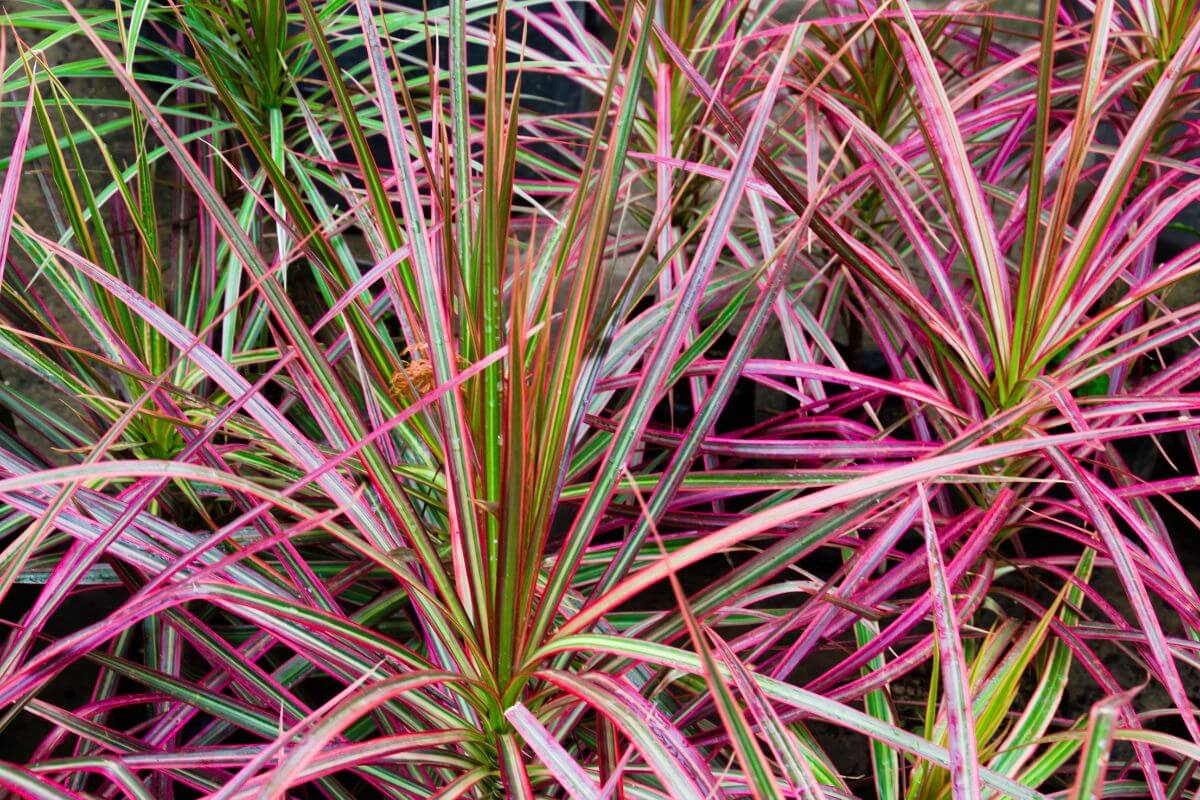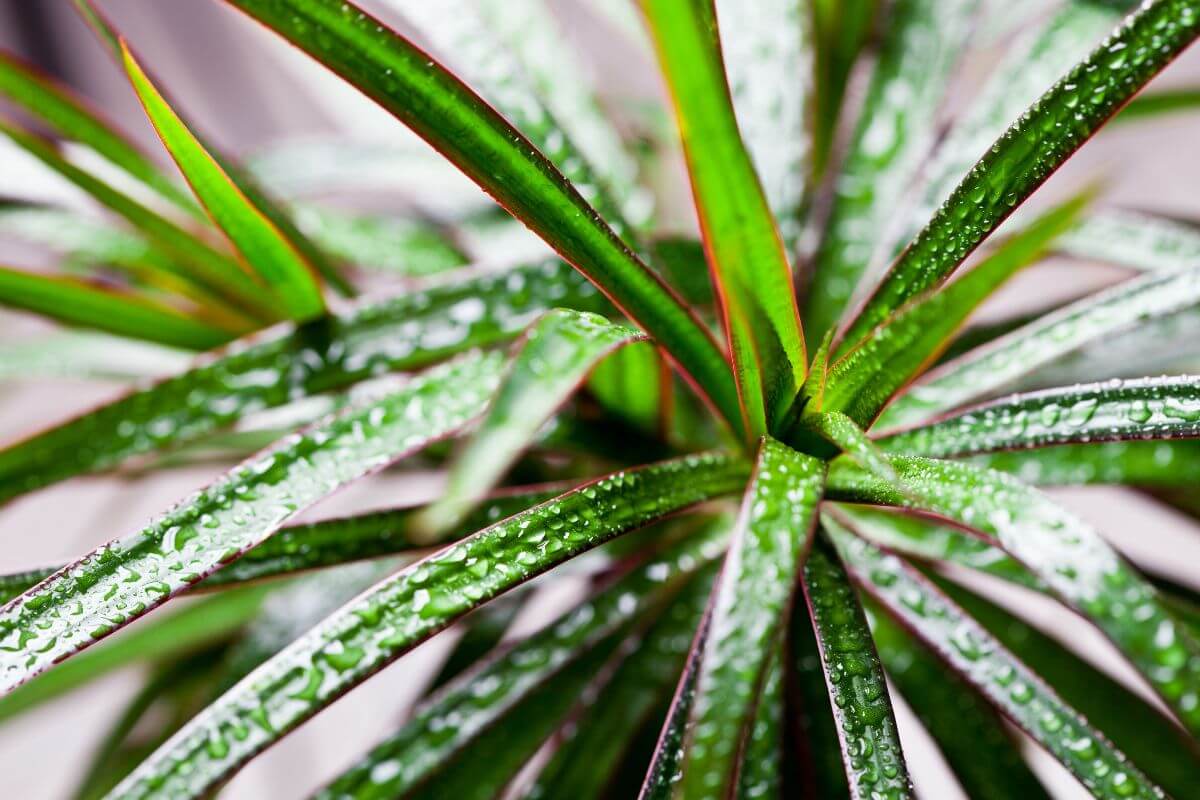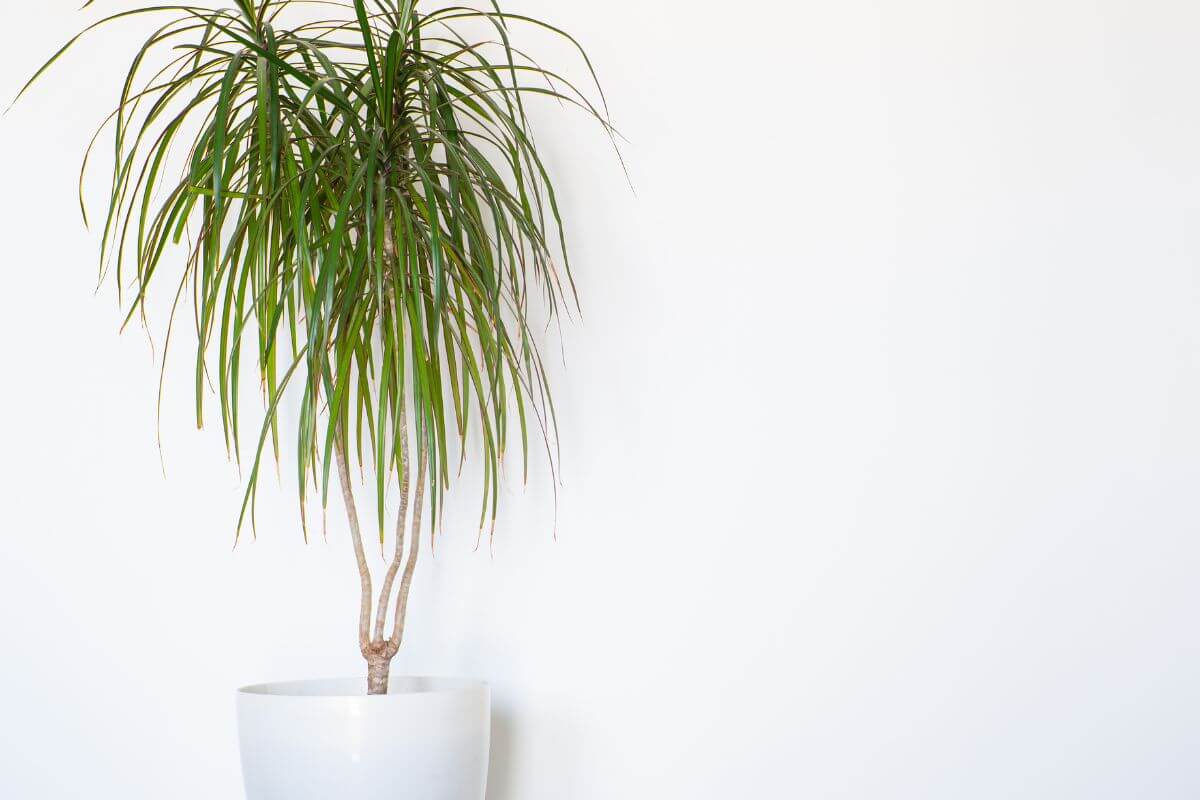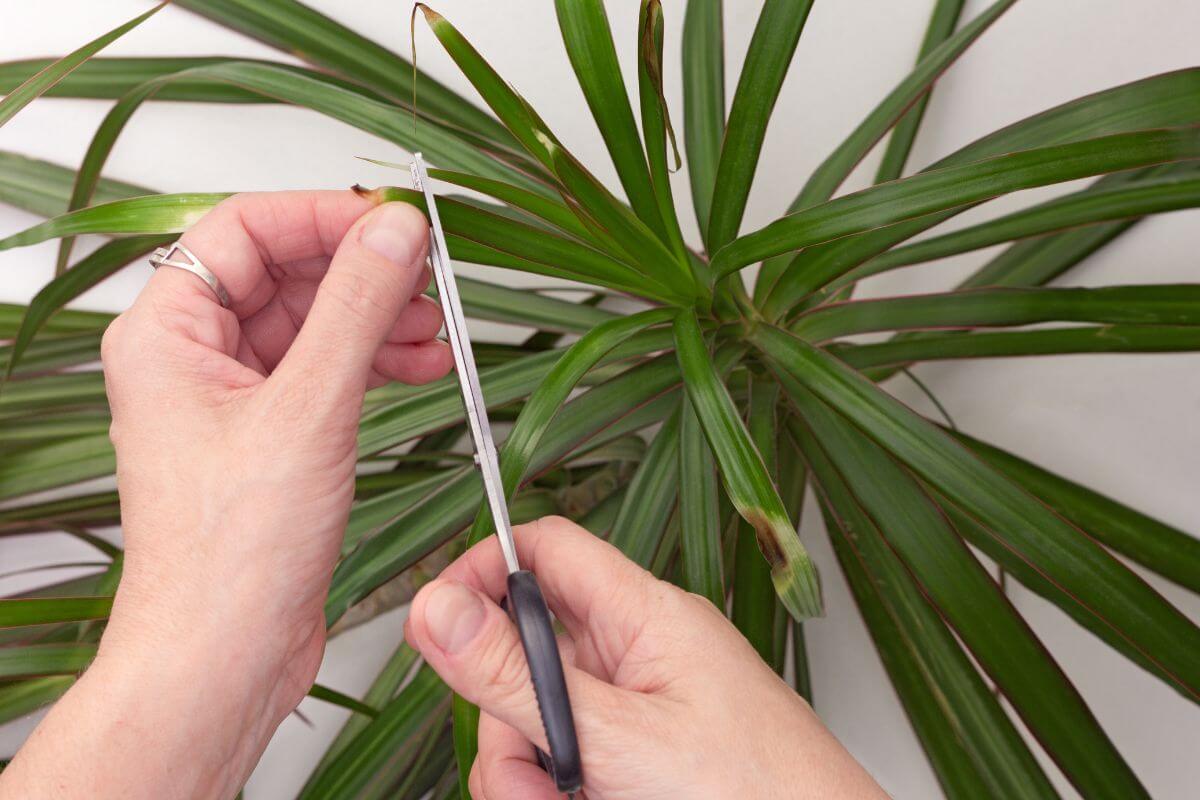The Madagascar Dragon Tree is a striking indoor plant resembling a miniature palm tree. It’s a beautiful plant that is known for its large leaves and bright red flowers. It is also known for being extremely hardy and drought tolerant.
It’s one of the easiest houseplants to care for and will add a touch of flair to any home or office.
If you want to learn more about dragon trees, then keep reading. In this article, I will give you a complete guide on how to care for these amazing plants.
Madagascar Dragon Tree Overview

The Dragon Tree calls Madagascar home, but due to its beauty combined with low maintenance requirements is now found worldwide in numerous homes and offices.
Officially named the Dracaena marginata, it’s easily recognizable thanks to its slim, striped, spiky leaves that resemble mini swords with red edges.
“Dracaena” originates from the Greek word for a female dragon. When the stems of this plant are cut, a red sap emerges. When the sap thickens, it is said to resemble the blood of dragons, and so the name.
The Dragon tree is literally indestructible, so if you are a beginner gardener, this is a great plant, to begin with. While it will need an occasional drink, it’s drought tolerant, so you won’t need to worry about it on a daily basis.
It grows slowly and can be planted any time during the year. If it is planted outdoors in a warm climate, it can grow to an impressive 20 feet and will bloom small petite white flowers in the springtime.
More often it is cultivated indoors as a houseplant. With pruning, it generally will reach six feet at the most. This plant will generally not produce flowers as an indoor plant.
Apart from being lovely and decorative, it is one of a group of houseplants that is beneficial to the environment, because it cleanses chemicals from the air we breathe.
Dragon trees will remove carbon dioxide from the air and then release pure oxygen into the air through photosynthesis. The larger a plant is, the more toxins it can remove.
Dragon Tree Varieties
There are a number of varieties of dragon trees, however, the most common found at nurseries or through a florist include:
- Dracaena marginata “Tricolor” – This has green leaves with dark red edges and a cream-colored stripe down the middle.
- Dracaena marginata “Colorama” – It may look completely pink, but it does feature green and white striping. This particular variety needs bright light to maintain its unique coloring.
- Dracaena marginata “Bicolor” – This dracaena boasts red and green stripes on its leaves.
Learn more about other dracaena plant varieties.
Dragon Tree Care Guide
Soil for the Dragon Tree
If you are growing your dragon tree indoors as a potted plant, it is important to pot it with a loose potting mix that above all is well-draining.
An ideal mix will be soil that is loamy mixed with some peat moss. The container or pot you use should have sufficient room for the plant’s root system, which can grow quite extensive.
Light for the Dragon Tree
The dragon tree likes bright, indirect light. This plant can adapt to medium or lower levels of light and still thrive.
They should not be positioned in harsh or hot direct sunlight, as this may lead to scorched leaves.
Water and Humidity for the Dragon Tree

As a drought-tolerant plant, your real risk will be of overwatering it. To avoid overwatering and damaging the plant, wait until at least the top half of the soil in your pot is dry before watering.
Depending on where you live and the average temperature in your home, this can take as long as three weeks. However, in most cases, watering once a week is a good rule of thumb. When you do water, do so thoroughly.
Watering should be less frequent during the winter months as it will take the soil longer to dry.
Should your dragon tree develop brown leaf tips, it may be receiving too much water, or it may be an indication of the quality of the water that you are giving it. The water may contain too much fluoride or salt that will cause it to discolor.
If your city or region has fluoride in the water, you can avoid issues by using distilled water. If yellow leaves appear on your plant, the plant is asking for more water.
Normal humidity is sufficient for the dragon tree. If your house tends to be dry or you live in a region with an arid climate, you can mist your plant with a spray bottle up to about twice a week.
Temperature for the Dragon Tree
This plant has great tolerance for varying temperatures however, it does prefer temperatures that sit between 70° and 80° Fahrenheit.
Hot and cold drafts, as well as low humidity, can lead to brown leaf tips.
Fertilizer for the Dragon Tree
Dragon trees have very little need for fertilizer. They are low feeders and slow growers, even if it sheds old leaves and constantly grows new ones.
It is not necessary for you to fertilize for the plant to thrive. If you do want to give them a boost, you can give them a well-balanced water-soluble fertilizer when spring arrives, continuing once or twice a month through the summer.
It is not a good idea to fertilize them during the winter as it won’t help it grow.
Pruning and Repotting the Dragon Tree

Pruning the dragon tree should be done during the second half of spring into early summer.
The dragon tree will allow lower leaves to drop, leaving a bare trunk while the umbrella of superior leaves will be denser.
Trees that grow outdoors will not require pruning, however, indoor potted plants will achieve denser foliage if pruned. This will give the plant a more rounded appearance.
How to Prune the Dragon Tree
- Cut away any excessive longer growth. Make a 45° angled cut to the stem, wherever on the stem you want to prune. A cut at a 45° angle will ensure that water isn’t collected at the point of cutting.
- Prune your stems back to encourage and stimulate denser growth. Dragon trees will promote growth at the tip of a stem. This makes the plant appear pretty bare at the base as it grows. If you prune a stem where you would like new growth, two stems should appear at the cut.
- Cut all dead stems to the principal cane. If you need to check, scratch the stem with a knife. If a green color shows, this indicates the stem is healthy. Should it be brown, the stem is either dying or already dead. An unhealthy stem will be soft or even soggy, and will look damaged.
- Remove any leaves that have discolored with scissors.
- Finally, water your dragon tree after you have pruned it, so that the soil bed is damp. This will help the plant recover after pruning and assist growth.
As your dragon tree grows, you may need to repot it to give the roots more space and provide new soil for its nutrition. If the roots begin to bulge out of the sides, you’ll know it needs repotting.
However, since these plants grow so incredibly slowly, you may only need to repot them every second year and even every third year without a problem.
If you want your plant to grow taller when you repot, choose a pot that is two inches larger in diameter. If you like the actual height of the plant, you can just change the soil.
How to Repot the Dragon Tree
You can care for you plant by refreshing the potting soil annually. This will substitute any soil that is compacted.
- Remove the plant from its pot.
- Shake off as much old soil as possible so that you have roots that are as clean as possible.
- Place your plant in the middle of the pot you are going to use.
- Add in the new potting soil and pat it down firmly.
- Water the plant with the new soil thoroughly
- Place it somewhere with bright, indirect sunlight.
A repotted dragon tree plant will generally need two to four full weeks to rebound from transplant shock.
Propagating the Dragon Tree
The dragon tree can be easily propagated. It’s great if you’d like to increase the number of dragon plants that you possess or would like to gift them.
You will need to use stem cuttings and root them in water. It is really easy to do. It will take approximately three weeks for your cuttings to sprout roots.
It is not necessary to use a rooting hormone. Once your roots have sprouted, you can transplant your baby dragon tree to potting soil.
How to Propagate the Dragon Tree
- Choose a branch or stem to propagate.
- With a pair of clean sharp scissors cut off the stem at a 445° angle.
- Place it in a clear glass with water. Submerge only the stem. No leaves should be in the water.
- Place it in bright light and be patient. Do not put it in direct sunlight.
- Change the water every several days so that it stays fresh. It will take about 3 weeks for the new roots to sprout.
- When the roots have developed, transfer your baby dragon tree to a container with potting soil.
- Choose the pot size in accordance with the size of the stem and of the roots. Do not select a pot that is too large.
In the first weeks after potting, water and drain regularly until the plant feels rooted in the potting soil.
Dragon Tree Pests, Diseases, and Problems

Should your tree shed its leaves, no need to worry as this is normal. But if it begins to look bare, then it is probably in distress.
The first thing to check is if you are overwatering. Overwatering can lead to other types of problems too like root rot, and brown and/or yellow leaves. Drooping leaves may also be an indication of overwatering or underwatering.
If you fear it’s been underwatered, stick your dragon tree in the shower for a quick one. Let it drain out completely. You should see the plant begin to revive within 24 hours.
If you have overwatered, check the soil bed at the bottom of your dragon tree. If it is moist, leave it alone until it completely dries out. If you suspect root rot, you need to repot the plant immediately with fresh potting soil.
If the leaves of your plant are turning brown, it may be due to fluctuations in the temperature. Your dragon tree will not react well to temperature changes that are sudden and drastic.
Protect your plant from air conditioning vents, heaters or heating elements and drafts from window or doors. Should you want to reshape your plant if it has brown tips, just snip them off following the shape of the leaf.
Cleaning your dragon tree is not easy because the leaves are so thin. You can mist it to clean dust off or clean the leaves with a moist towel or cloth.
The dragon tree is pretty resistant to disease, but it is at risk from common plant pests like mealybugs, scale, spider mites, and thrips.
A mealybug will leave proof of its presence with a deposit that is cottony on the leaves. The spider mite will appear if temperatures warm up and the air becomes dry. They are not as easy to see, and it is most likely that you will see the damage before you see the bug.
Scale insects will adhere to the plant and suck the sap. Since each type of pest requires a different treatment, it will be important to identify them correctly.
Dragon Tree Toxicity and Pets
As beautiful as a dragon tree is, it is equally poisonous. It is not toxic to humans, but the leaves are extremely poisonous for dogs and cats.
Unfortunately, cats love to nibble on the dragon tree’s leaves, perhaps because it resembles a type of grass. But the leaves contain alkyds, which are toxic.
If your dog or cat exhibits any of the following symptoms, take them to a veterinarian as soon as possible. Symptoms of dragon tree poisoning include:
- Diarrhea
- Excessive drooling
- Irritation inside or around the mouth area
- Lack of coordination
- Lethargy
- Loss of appetite
- Swelling of the face
- Vomiting
- Weakness
Madagascar Dragon Tree Care Final Thoughts
The dragon tree is truly an attractive plant addition to any home or office. It is fantastic as a beginner houseplant.
Particularly easy to care for, it requires little water, indirect light and is a hardy plant that will manage in a range of temperatures. It resembles a small palm tree and radiates plenty of joy to brighten wherever it is positioned.
Other houseplant care guides that we have:
Madagascar Dragon Tree Care FAQs
What is dragon tree good for?
The Dragon Tree is great for as an indoor plant! This tropical evergreen shrub grows best when placed near windows where there is lots of sunlight. It’ll give your home a tropical, relaxing feel.
How do I grow a Madagascar Dragon Tree indoors?
Grow the Madagascar Dragon Tree indoors in a pot that’s large enough to accommodate the size of the root ball. Fill the bottom half of the container with pebbles or gravel to allow water to drain. Next add some soil mixed with perlite. Finally, place the plants into their new homes. Water thoroughly after planting. Once established, keep the plants watered regularly to keep the soil evenly moist throughout the growing season. If necessary, repot every two years as the roots grow larger than the container.
Where should I place my dragon tree?
Place your dragon trees in an area where it’ll receive lots of bright, indirect light. They can tolerate direct exposure to direct sunlight without harm for short periods of time. A humid environment also helps it flourish.
Is the dragon tree drought tolerant?
Yes, the Madagascar Dragon Tree is very drought tolerant. However, it does require regular watering once established, about once every 1-2 weeks. Keep the soil consistently damp so that the top layer stays slightly wet all year round.
How dangerous is the dragon tree?
While the Madagascar Dragon Tree is not toxic to humans, its leaves may be harmful if ingested by pets such as dogs and cats. The leaves contain alkyds, which cause vomiting and diarrhea in animals who ingest them. In severe cases, these toxins could result in death. Therefore, make sure you don’t let your pet eat the leaves.
Should you mist a dragon tree?
You can mist a dragon tree if you live in a dry environment, because it’s a tropical plant and likes a humid environment. You can mist the plant 1-2 times a week. Be sure to regularly water the plant as well to keep the soil mist.
How long do dragon trees live?
There’s no exact range of how long dragon trees live, but they can live for hundreds to thousands of years in its native environment. Indoors, the dragon tree can grow up to six feet tall. Outdoors, it can grow up to 20 feet or even more in the right environment. Natively, they could even grow to 60-70 feet.


